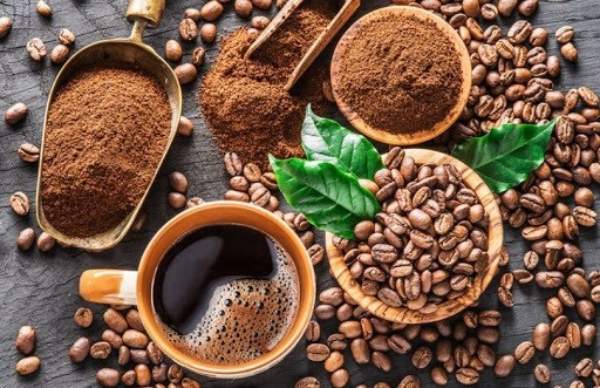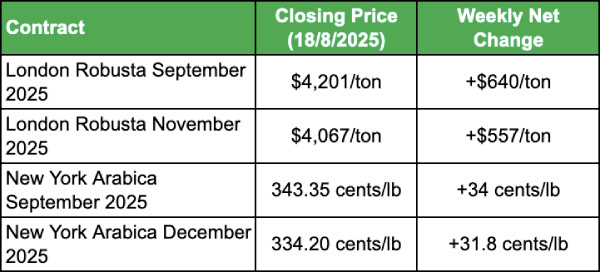Vietnam’s Market Hits Record Highs
At the start of the week on August 11, Vietnam’s domestic market was stable, with prices hovering between VND 103,500 and VND 104,000 per kilogram. The highest price was in Dak Nong, at VND 104,000/kg, followed by Dak Lak, Gia Lai, and Lam Dong.
By the end of the week, prices had exploded. On August 18, prices in key provinces reached these record levels:
- Dak Nong: VND 117,500/kg (up 13.0%)
- Dak Lak: VND 117,300/kg (up 13.0%)
- Gia Lai: VND 117,200/kg (up 13.1%)
- Lam Dong: VND 116,800/kg (up 12.8%)
The rapid price increase created a complex situation. High domestic prices prompted some warehouses to stop buying, a move that could slow Vietnam’s exports. This action, however, tightened global Robusta supply, which in turn contributed to the worldwide price increase. The intricate link between Vietnam’s domestic market and global trends shows that the actions of Vietnamese producers directly impact the global Robusta supply chain.

Global Coffee Prices Soar: Robusta and Arabica Climb
The week of August 11-18, 2025, saw significant gains in the global coffee market. Both Robusta and Arabica prices jumped, driven by a mix of market forces and supply chain issues.
Futures Market Performance
- London Exchange (ICE Robusta): The September 2025 futures contract surged 18%, closing at $4,201 per ton. The November contract also rose sharply, up 15.9% to $4,067 per ton. This strong performance signals robust demand for Robusta coffee.
- New York Exchange (ICE Arabica): Arabica prices followed a similar trajectory. The September 2025 contract increased 11%, reaching 343.35 US cents per pound. On August 15, the price hit a new high, nearly 40% above the same period last year.
Inventory and Price Signals: A Mixed Picture
While certified Arabica inventories on the New York exchange showed a slight increase, the number of lots waiting for inspection fell significantly. This suggests that new physical supplies are not entering the market quickly, possibly due to shipping delays. This discrepancy between rising inventory and a slowdown in new supplies points to a tightening market.
Another key factor is the widening price gap between Robusta and Arabica. This trend shows a stronger demand for Robusta, making its price discount less attractive to buyers. As a result, some buyers are likely shifting to the Arabica market, further contributing to its price increase.
Table 1: Main Coffee Futures Contract Prices (August 11-18, 2025)

Speculation Fuels Coffee Price Surge
The latest Commitment of Traders (COT) report highlights a clear shift in coffee market sentiment. During the week ending August 12, speculators and hedge funds made significant moves, betting on higher prices.
- On the New York Arabica exchange, speculators boosted their net long positions by 4.09%. This move shows confidence in future price gains.
- Meanwhile, on the London Robusta exchange, hedge funds slashed their net short positions by 27.38%. This indicates they are no longer betting on falling prices, but instead expect them to rise.
This collective optimism has driven the market’s recent rally. The price increase isn’t just a result of fundamental supply and demand; it is being actively pushed by speculative buying and short-covering. As a result, the market is highly sensitive to trader sentiment. A shift in macroeconomic factors or negative news could trigger a sharp correction.
Coffee Exporters Navigate a Shifting Global Landscape
The world’s top coffee-producing nations are facing a complex mix of challenges and opportunities. While some countries are struggling with trade disputes and climate issues, others are seeing record-breaking production and export growth.
Brazil: Tariffs and Weather Create Headwinds
As the world’s largest coffee exporter, Brazil is grappling with significant challenges. Although its harvest is 94% complete, with Robusta nearing 96%, low rainfall in the key Arabica region of Minas Gerais raises concerns about future crop yields.
Adding to the pressure, the U.S. imposed a 50% tariff on Brazilian coffee on August 6, 2025. This move has disrupted traditional supply chains, forcing Brazil to find new markets in places like China and the EU. The tariff also translates to a 15-20% price increase for U.S. consumers. As a result, Brazil’s green coffee exports plummeted in July 2025, falling 28% year-over-year. Arabica exports were down 21%, and Robusta exports saw a sharp 49% drop.
Colombia: A Decade of Record Growth
In stark contrast to Brazil, Colombia is celebrating a record-breaking period for its coffee industry. In July 2025, production hit 1.37 million 60kg bags, the highest level in a decade and a 19% increase from the previous year. This surge was primarily due to unusual rains that delayed the main harvest into July.
Thanks to this abundant supply, Colombia’s coffee exports in July rose 12%, reaching 1.15 million bags. Over the past 12 months, total exports have grown to 13.1 million bags, up 14%. The value of exports also soared, increasing by a remarkable 83.2% to $2.69 billion in the first half of 2025, signalling a strong recovery for the sector.
Indonesia and India: Navigating Unique Challenges
Indonesia is enjoying one of its best coffee seasons in years, with production up 20% compared to 2024. However, a new law requiring a three-month freeze on 30% of funds for exports over $250,000 has increased logistics costs, posing a challenge for exporters.
Meanwhile, India is facing adverse weather, including high temperatures and heavy rains, which have impacted its crops. Despite these issues, the country’s coffee exports are projected to hit a record $1.816 billion for the 2024-25 fiscal year. Strong domestic demand, particularly for instant coffee, is expected to continue supporting the industry.
In summary, the global coffee landscape is in a state of flux. While some major producers face significant hurdles, others are capitalising on favourable conditions to expand their market share. These diverse challenges and successes are collectively reshaping the dynamics of the global coffee trade.
See further:



